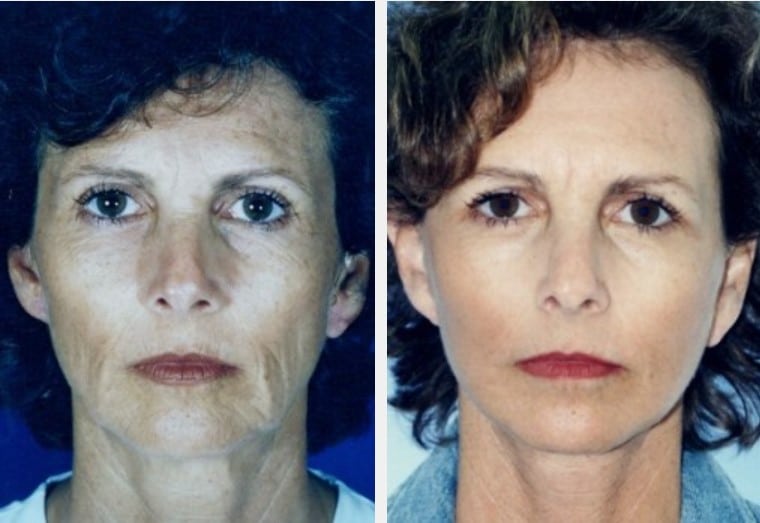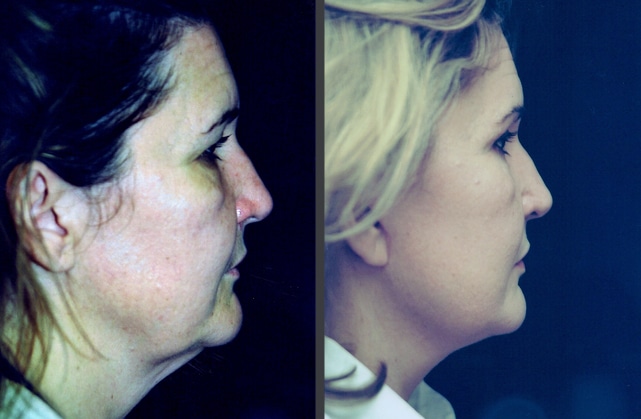Over time, gravity, sun exposure, and the stresses of daily life take their toll on our faces and necks. Deep creases form beside the mouth, the jaw line slackens and becomes jowly, and the neck develops loose folds and fat deposits.
Facelifts can counteract these signs of aging by tightening muscles, removing excess fat, and trimming loose skin, giving your face a fresher and more youthful appearance.
Facelifts, technically known as rhytidectomies, which literally means "removal of wrinkles", rejuvenate the mid to lower face and neck. At Cosmetique Cosmetic Surgery Center, Dr. Robert Hunsaker, a board-certified plastic surgeon and Fellow of the American College of Surgeons, can help patients look 10-15 years younger.
What Is A Facelift?
Over time, gravity, sun exposure, and the stresses of daily life take their toll on our faces and necks. Deep creases appear beside the mouth, the jaw line slackens and becomes jowly, and the neck develops loose folds and fat deposits. Facelifts can counteract these signs of aging by tightening muscles, removing fat, and trimming excess skin. Giving your face a fresher and more youthful look.

Facelifts, technically known as rhytidectomies, which literally means "removal of wrinkles", rejuvenate the mid to lower face and neck. After surgery at our cosmetic surgery center, patients can look 10-15 years younger.
Benefits Of Facelift Surgery
Facelifts are most effective for patients who want to correct deep creases and sagging on the face. They will not rejuvenate the brow, eyelids, nose, and some of the midface. Patients who want to improve these areas may consider combining a facelift with a brow lift or eyelid surgery (blepharoplasty). Patients can also enhance the effects of a facelift with injectable soft-tissue fillers, facial implants, and skin resurfacing.
Facelift surgery can help the following issues:
- Midface sagging
- Deep creases under the eyes
- Deep creases between the nose and mouth (nasolabial folds)
- Jowls due to loss of muscle tone
- Sagging areas of fat
- Loose skin and fat under the chin and jaw
Facelift Before And After

What Are The Advantages Of A Surgical Facelift Versus A Liquid Facelift?
Although you often hear radio ads here in South Florida from certain practices promising an equal amount of rejuvenation with a liquid facelift, where dermal fillers are used in lieu of surgery, there really isn’t any comparison in the level of rejuvenation between these two procedures. Yes, dermal fillers are excellent for addressing sagging around the mouth, and they can be effective for returning volume to the cheeks. But for patients with real issues with sagging skin, jowls, and neck banding, a surgical facelift is really the only answer.
Surgical facelifts with Dr. Hunsaker, take from 10-15 years off the facial age of his patients. Obviously, the results are permanent, although the natural aging process will continue. Still, future aging will begin from a younger starting point than it was previously.
Liquid facelifts are best for patients with only limited sagging. They last about one year and then another session is necessary to maintain your results.
Who Is A Candidate For A Facelift?
The best candidates for a rhytidectomy are men or women that want to improve the signs of aging. Candidates typically have facial sagging but elasticity still remains in their skin. Additionally, candidates will need to be healthy, not a smoker, and have realistic expectations about their appearance.
Can I Combine A Facelift With Other Procedures?
The name “facelift” can make some potential patients think the procedure will rejuvenate their entire face. That’s not the case. The different facelift methods used by Dr. Hunsaker target areas from under the eyes down through the jowls. Facelifts don’t rejuvenate the eyelids, nor do they correct aging on the upper third of the face.
For wider facial rejuvenation, many of our Cosmetique patients opt to combine their facelift with eyelid surgery and/or a brow lift. These combinations widen the scope of correction of sagging tissues and loosened support muscles.
If you’re interested in combining another procedure with your facelift, discuss this with Dr. Hunsaker during your consultation.
What Results Should I Expect From My Facelift?
Unfortunately, the results of a facelift do not last forever and do not stop the aging process. In time, signs of aging will gradually appear once again. You may want to consider having another procedure in five or ten years. However, the effects are permanent so years later, your face will continue to look better than if you had never had a facelift.
How Can I Prepare For A Facelift?
Basic preparations will be the same as with any surgery. You’ll stop taking any blood thinning medications, aspirin, anti-inflammatory medications, and most herbal supplements for one week prior to your surgery. If you smoke, you’ll need to stop for at least two weeks prior to and after your procedure because cigarette smoking constricts the blood vessels, and this impedes healing.

We want our Cosmetique facelift patients to spend much of their preparation thinking about their recovery. The beginning of your recovery after your facelift with Dr. Hunsaker will be the most difficult. You’ll need to sleep with your head elevated for one full week. You’ll need to be sure not to roll onto your side or face. You’ll need to use cold compresses to help manage your swelling and bruising.
So, you’ll want to prepare a recovery nest complete with lots of pillows, blankets, and all the entertainment you need. The pillows will be used to prop you upright and to keep you from rolling over in your sleep. For the first week, you won’t want to do much, so having a really comfy recovery nest is important.
Of course, preparation also involves things like work and stuff around the house. You’ll need to arrange to miss time from work. You’ll also want someone around to handle cooking and household chores. This isn’t the time to be the lone ranger.
Facelift Surgery
Facelifts are typically outpatient procedures and patients may have a choice of IV sedation or general anesthesia. The procedure takes about three to four hours but varies depending on the patient's facial structure and the extent of correction desired. Some of the most common facelift procedures include:
- Traditional facelift or the "full" facelift is performed to rejuvenate the face, jowls, and neck. This includes fat sculpting, lifting and repositioning of muscle and deeper tissues, and skin trimming and redraping. The incision begins at the temples and travels down to the front of the ear, around the earlobe, and behind the ear to the lower scalp at the hairline.
- Limited-incision facelift is used for rejuvenation around the eyes, mouth, nasolabial folds, and other deep creases. Short incisions are made at the temples and around the ear, and possibly in the lower eyelids and/or under the upper lip as well.
- A neck lift concentrates on jowls, loose skin on the neck, and fat under the chin. The incision is made around the earlobe and behind the ear to the lower scalp.

"Every interaction I’ve had with Dr. Hunsaker and his staff has been a positive one. His staff is highly trained and make you feel like family. I highly recommend them. Go in for a consult and ask a million questions. They’ll walk you through it and set your mind at ease."
Facelift Before And After

What Is Recovery Like After A Facelift?
As noted above, the tissue repositioned by Dr. Hunsaker will create a good deal of swelling and bruising. This is a universal part of any facelift method used. After your surgery, Dr. Hunsaker will have your face wrapped in bandages and you will likely have some drainage tubes in place. The first few days can be difficult, but from there you’ll rapidly improve. You’ll have to sleep with your head elevated for at least the first week and sleeping on your face must be absolutely avoided. At first, your skin will feel tight. When the pain subsides, you will have numbness in areas, especially on your incisions. Most patients can return to work after around three weeks.
One of the main areas of focus during recovery needs to be keeping blood pressure from rising on your face. As for exercise and lifting, you’ll need to be careful. Dr. Hunsaker will give you general timelines for returning to exercise and such, but you’ll also need to monitor this yourself. Even bending over needs to be avoided.
Patience is key in your recovery. This isn’t the time to push yourself. Facelifts can have residual swelling that returns, usually in the evening, for weeks, even months. This is completely normal; it takes time for the skin to adjust to the changes. Also, your incisions will heal and change from feeling numb to itching. This also is normal, as the nerves adapt to their locations on the re-draped skin. All in all, a facelift will show your full results after about six months, but full healing can take one year.
Is Facelift Recovery Very Painful?

These aren’t simple recoveries. Dr. Hunsaker lifts and repositions a large amount of facial tissue, and this creates extensive tissue trauma, which shows itself in swelling and bruising. The first few days of your recovery will present the most discomfort, but we provide prescription pain medication to manage the pain.
What Are The Risks Associated With A Facelift?
Dr. Hunsaker will discuss the risks and benefits of a facelift with you before your surgery. Along with the standard risks that come with any surgery there are facelift specific complications that can occur. These include bleeding, infection, bruising, uneven swelling or discoloration, skin blistering, and temporary or permanent loss of sensation in the face.
How Long Will I Have Swelling After A Facelift?
As discussed above, swelling endures with these procedures. There is simply a large amount of tissue that is lifted and repositioned, and this creates swelling. Your initial recovery and swelling will last a few weeks but swelling can return at night for months.
What Will My Scarring Be Like After My Facelift?
Dr. Hunsaker is a board-certified plastic surgeon with a quarter century of surgical experience. He uses his expertise to effectively hide your incisions. He uses the natural chin crease and hides the ear incisions in the hairline as much as possible. These scars will heal well naturally and will be quite inconspicuous in a matter of months.

How Soon After My Facelift Can I Resume Exercise?
After major surgery such as a facelift, most patients want to get their blood moving again and get back to their exercise routine. But some patience here pays off — exercising too soon after a facelift can lead to complications and create a longer recovery.
For the first few days of your recovery, Dr. Hunsaker encourages short, light walks to encourage blood circulation. But you don’t want to increase your heart rate or blood pressure, as this can cause the tiny blood vessels beneath your facial skin to bleed.
For the remainder of the first month, activity levels can increase, but heavy lifting, weight training, and any strenuous exercise needs to be avoided. You need to keep your facial blood pressure down.
Four weeks after surgery, you can add light cardio exercise back to your routine, things like slowly pedaling a stationary bike or light aerobics. At six weeks, you can usually return to all exercise, including weight training and strenuous exercise. This can vary by the patient, however.
At What Age Do Most People Consider Getting a Facelift?
While there isn't a specific age requirement, most people begin considering facelift surgery in their 40s to 60s. This is when signs of aging, such as sagging skin, deep folds, and jowls, become more noticeable.
Skin quality, genetics, and lifestyle habits like sun exposure or smoking often influence timing more than age alone. Some individuals opt for a facelift earlier to maintain a youthful look, while others wait until the changes are more pronounced. The best time is when you feel the changes in your face no longer reflect your energy or how you want to present yourself.
How Do Facelifts Differ for Men vs. Women?
Facelifts are effective for both men and women. However, the surgical approach often varies to suit distinct facial structures and aesthetic goals.
For men, preserving natural features such as a strong jawline and avoiding visible scarring is important – particularly for those who opt for shorter hairstyles. Incisions may be placed differently to maintain a masculine appearance.
For women, the goal often emphasizes restoring youthful contours, smoothing the neck and jowls, and blending incisions discreetly within hairlines.
Regardless of gender, Dr. Hunsaker customizes techniques to produce natural-looking results that complement each patient's unique facial anatomy and desired outcome.
How Soon Can I Wear Makeup After Facelift Surgery?
Patients should wait until incisions are well-healed before applying makeup to avoid irritation or infection. Typically, this means holding off for about two weeks after surgery, though the exact timing depends on your healing progress.
When cleared by Dr. Hunsaker, you can begin with light, non-irritating products to help camouflage residual bruising or redness. Mineral-based cosmetics are often recommended because they're gentler on healing skin. It's also essential to apply makeup with clean brushes or sponges to avoid introducing bacteria.
Will I Need Someone To Stay With Me the First Night After Surgery?
Yes, having a responsible adult stay with you during the first night after facelift surgery is highly recommended.
In the immediate hours following anesthesia and surgery, you may feel groggy, disoriented, or need assistance moving around safely. A caregiver can help monitor your bandages, manage prescribed medications, and support you with basic needs such as preparing food or helping you to the restroom. This extra support provides comfort and reduces risks during the initial recovery phase.
Dr. Hunsaker and his team will also provide detailed aftercare instructions to guide both you and your caregiver.
Why Choose Cosmetique Cosmetic Surgery Center?
Cosmetique Cosmetic Surgery Center is led by Dr. Robert H. Hunsaker, a board-certified plastic surgeon with more than 25 years of experience specializing in facial and body procedures. His reputation is built on sound surgical judgment, refined technical ability, and the personal attention he gives each patient.
Trained at institutions such as Ohio State University, UNC, and the University of Miami, Dr. Hunsaker has also served as a residency director and published research on advanced techniques in facelifting. With a career dedicated exclusively to aesthetic surgery, he offers patients in Miami a premier level of care and expertise.
Schedule A Consultation
If you are interested in Facelift surgery, please contact Cosmetique Cosmetic Surgery Center. Call us at 305.279.4700 to schedule a consultation with Dr. Hunsaker. Our practice serves Miami, FL and surrounding areas.

